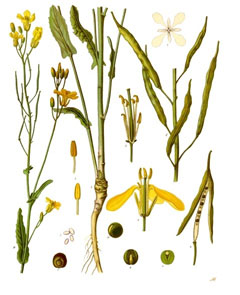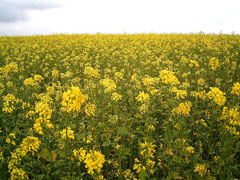 |
|
http://commons.wikimedia.org/wiki/File:Koeh-169.jpg |
 |
| http://commons.wikimedia.org/wiki/User:Ies |
Translate this page:
Summary
Physical Characteristics

 Brassica_napus is a ANNUAL/BIENNIAL growing to 1.2 m (4ft).
Brassica_napus is a ANNUAL/BIENNIAL growing to 1.2 m (4ft).
See above for USDA hardiness. It is hardy to UK zone 7 and is not frost tender. It is in flower from May to August. The species is hermaphrodite (has both male and female organs) and is pollinated by Bees. The plant is self-fertile.
Suitable for: light (sandy), medium (loamy) and heavy (clay) soils, prefers well-drained soil and can grow in heavy clay soil. Suitable pH: mildly acid, neutral and basic (mildly alkaline) soils and can grow in very acid and very alkaline soils.
It can grow in semi-shade (light woodland) or no shade. It prefers moist soil.
UK Hardiness Map
US Hardiness Map
Synonyms
Plant Habitats
Edible Uses
Leaves - raw or cooked[4, 34, 37]. Added to salads or used as a potherb[183, 272]. The leaves are also fermented for later use[272]. Immature flowering stems - cooked in much the same way as broccoli[183]. An edible oil is obtained from the seed, it is used mainly for cooking purposes, but can also be used raw in salad dressings[4, 13, 34, 46, 183]. Some caution is advised, however, see the notes above on toxicity. The sprouted seed is often used as the mustard part of mustard and cress. Eaten in salads[4, 34, 37, 183]. The seed is used as a mustard flavouring[183].
References More on Edible Uses
Medicinal Uses
Plants For A Future can not take any responsibility for any adverse effects from the use of plants. Always seek advice from a professional before using a plant medicinally.
The root is emollient and diuretic[240]. The juice of the roots is used in the treatment of chronic coughs and bronchial catarrh[240, 269]. The seed, powdered, with salt is said to be a folk remedy for cancer[269]. Rape oil is used in massage and oil baths, it is believed to strengthen the skin and keep it cool and healthy. With camphor it is applied as a remedy for rheumatism and stiff joints[269]. It is dropped into the ear to relieve earaches[272].
References More on Medicinal Uses
The Bookshop: Edible Plant Books
Our Latest books on Perennial Plants For Food Forests and Permaculture Gardens in paperback or digital formats.

Edible Tropical Plants
Food Forest Plants for Hotter Conditions: 250+ Plants For Tropical Food Forests & Permaculture Gardens.
More

Edible Temperate Plants
Plants for Your Food Forest: 500 Plants for Temperate Food Forests & Permaculture Gardens.
More

More Books
PFAF have eight books available in paperback and digital formats. Browse the shop for more information.
Shop Now
Other Uses
The seed contains up to 45% of an edible semi-drying oil, it is used as a luminant, lubricant, in soap making etc[13, 21, 57, 142]. Rapeseed oil has potential market in detergent lubrication oils, emulsifying agents, polyamide fibres, and resins, and as a vegetable wax substitute. According to the Chemical Marketing Reporter (April 26, 1982) "the most common use for the oil is still in the production or erucic acid, a fatty acid used in turn in the manufacture of other chemicals[269]. The seed husks are used in plastering house walls[272]. A good green manure, the deep taproot improves drainage and loosens heavy soils[18, 20, 87].
Special Uses
References More on Other Uses
Cultivation details
Succeeds in full sun in a well-drained fertile preferably alkaline soil[200]. Succeeds in any reasonable soil[52]. Prefers a heavy soil and cool moist conditions[16, 20]. Sunny days and cool nights are favourable for plant growth whilst dry weather at harvest time is essential[269]. Colza is reported to tolerate an annual precipitation of 30 to 280cm, an annual average temperature range of 5 to 27°C and a pH in the range of 4.2 to 8.2[269]. Very young plants are susceptible to cold damage, -4°C either killing or injuring seedlings, whereas -2°C has no affect when the plants are more than one month old[269]. Brassica napus is an aggregate species, probably derived through cultivation. It is thought that crosses of Brassica oleracea subsp. oleracea with B. rapa gave rise to the subsp. B. napus pabularia, from which subsp. napus and subsp. rapifera and other cvs were derived[269]. The aggregate species includes forms with swollen edible roots (B. napus napobrassica, the garden swede), forms grown for their oil-rich seeds (B. napus napus, the oilseed rape), forms grown for their edible leaves (B. napus pabularia, the rape kales) whilst the form grown as a green manure is B. napus arvensis. All these forms are treated separately here. The oil obtained from the seed is high in erucic acid and glucosinolates, both of which have anti-nutritional properties. Cultivars have been developed that have a low content of these items and are therefore suitable for food. Colza is 70% self-pollinating and 30% cross-pollinated. Even if wind and insects are absent, seed are still produced. Yield increases with honeybees[269]. The growth of this plant is inhibited by field mustard and hedge mustard growing nearby[18, 20]. This species is closely related to B. rapa[200].
References Carbon Farming Information and Carbon Sequestration Information
Temperature Converter
Type a value in the Celsius field to convert the value to Fahrenheit:
Fahrenheit:
The PFAF Bookshop
Plants For A Future have a number of books available in paperback and digital form. Book titles include Edible Plants, Edible Perennials, Edible Trees,Edible Shrubs, Woodland Gardening, and Temperate Food Forest Plants. Our new book is Food Forest Plants For Hotter Conditions (Tropical and Sub-Tropical).
Shop Now
Plant Propagation
Seed - sow in situ in early spring to mid-August for a green manure crop.
Other Names
If available other names are mentioned here
Native Range
Coming Soon
Weed Potential
Right plant wrong place. We are currently updating this section.
Please note that a plant may be invasive in one area but may not in your area so it's worth checking.
Conservation Status
IUCN Red List of Threatened Plants Status :

Growth: S = slow M = medium F = fast. Soil: L = light (sandy) M = medium H = heavy (clay). pH: A = acid N = neutral B = basic (alkaline). Shade: F = full shade S = semi-shade N = no shade. Moisture: D = dry M = Moist We = wet Wa = water.
Now available:
Food Forest Plants for Mediterranean Conditions
350+ Perennial Plants For Mediterranean and Drier Food Forests and Permaculture Gardens.
[Paperback and eBook]
This is the third in Plants For A Future's series of plant guides for food forests tailored to
specific climate zones. Following volumes on temperate and tropical ecosystems, this book focuses
on species suited to Mediterranean conditions—regions with hot, dry summers and cool, wet winters,
often facing the added challenge of climate change.
Read More
Expert comment
Author
L.
Botanical References
200
Links / References
For a list of references used on this page please go here
Readers comment
| Add a comment |
|
If you have important information about this plant that may help other users please add a comment or link below. Only comments or links that are felt to be directly relevant to a plant will be included. If you think a comment/link or information contained on this page is inaccurate or misleading we would welcome your feedback at [email protected]. If you have questions about a plant please use the Forum on this website as we do not have the resources to answer questions ourselves.
* Please note: the comments by website users are not necessarily those held by PFAF and may give misleading or inaccurate information.
To leave a comment please Register or login here All comments need to be approved so will not appear immediately.
|
|